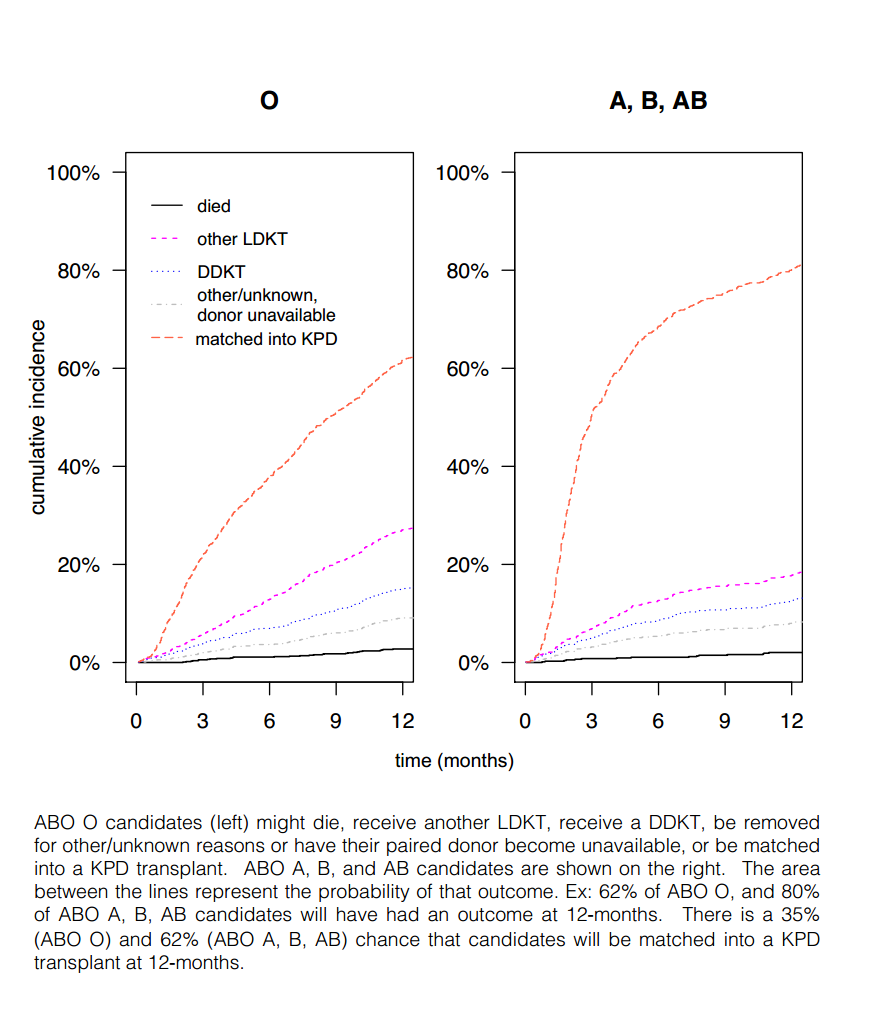Sensitized KPD Pairs Take Longer to Find Matches.
1Johns Hopkins University, Baltimore
2National Kidney Registry, New York
3US Naval Academy, Annapolis
Meeting: 2017 American Transplant Congress
Abstract number: D233
Keywords: Kidney transplantation, Patient education
Session Information
Session Name: Poster Session D: Living Donor Kidney Transplant II
Session Type: Poster Session
Date: Tuesday, May 2, 2017
Session Time: 6:00pm-7:00pm
 Presentation Time: 6:00pm-7:00pm
Presentation Time: 6:00pm-7:00pm
Location: Hall D1
Kidney paired donation (KPD) can facilitate living donor transplantation for candidates with an incompatible donor, but it is unclear how sensitization or blood type affects the success of matching.
METHODS: We retrospectively studied disposition of donor/candidate pairs who registered for the National Kidney Registry (NKR) 10/11-9/15 using a competing risk model.
RESULTS: Registrant candidates (N=1894) were 52.3% male, average age 49 years, 65.9% white, 59.4% ABO O, and 41.8% had PRA 80+ (Table). Overall, 50.5% registrants obtained KPD through NKR, 5.4% obtained KPD by other means, 7.3% found a compatible donor, 9.4% received a DDKT, 4.0% had their paired donor become unavailable, 4.8% died or were too sick to remain registered, 6.8% were removed for other reasons, and 11.9% continued to wait (Figure). Candidates with PRA 80-97 and 98+ were 23% [95% CI: 6.0-37%] and 83% [78-87%] less likely to be matched than PRA 0 candidates. ABO O candidates were 67% [60-72%] less likely to be matched versus ABO A. Candidates with ABO B or O donors were 25% [5-50%] more likely and 116% [81 -160%] more likely to match versus ABO A donors. Older candidates had increased chance of matching by 5% for each decade of age [0.2-10%].
CONCLUSIONS: Candidates who are highly sensitized or have blood type O may have longer waiting times for KPD.
Table. Demographics of Registrant Pairs
| Candidate | Paired Donor | |
| Male Gender | 52.3% | 38.0% |
| Race/Ethnicity | ||
| Asian | 4.9% | 4.1% |
| Black | 14.4% | 12.3% |
| White | 65.9% | 69.5% |
| Latino | 10.6% | 9.8% |
| Other | 4.2% | 4.2% |
| ABO Type | ||
| A | 23.8% | 46.9% |
| AB | 2.1% | 5.2% |
| B | 14.7% | 17.6% |
| O | 59.4% | 30.2% |
| Unk | 0 | 0.1% |
| PRA | ||
| 0 | 29.0% | |
| 1-79 | 29.2% | |
| 80-97 | 17.9% | |
| 98+ | 23.9% |
Figure. Time to Transplant in NKR.
CITATION INFORMATION: Holscher C, Chow E, Purcell C, Ronin M, Garonzik-Wang J, Massie A, Gentry S, Segev D. Sensitized KPD Pairs Take Longer to Find Matches. Am J Transplant. 2017;17 (suppl 3).
To cite this abstract in AMA style:
Holscher C, Chow E, Purcell C, Ronin M, Garonzik-Wang J, Massie A, Gentry S, Segev D. Sensitized KPD Pairs Take Longer to Find Matches. [abstract]. Am J Transplant. 2017; 17 (suppl 3). https://atcmeetingabstracts.com/abstract/sensitized-kpd-pairs-take-longer-to-find-matches/. Accessed December 28, 2025.« Back to 2017 American Transplant Congress
